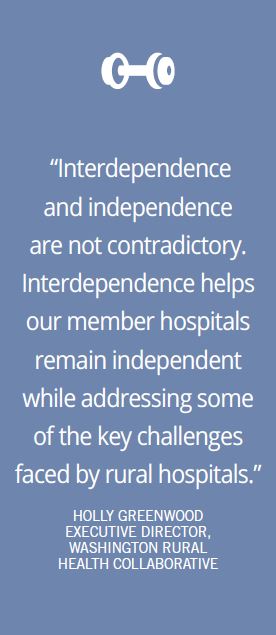Anyone traveling outside Washington State’s major population centers knows that the region is as geographically diverse as they come.
From the lavender-scented San Juan islands in the west to the forested peaks and valleys flanking the Pend Oreille River on the east, the state’s rural towns are as unique as their picturesque surroundings.
The small independent hospitals in these communities, staffed by caring local providers with a deep knowledge of the local culture, reflect the values of the regions they serve. It makes sense, then, that these rural hospitals would want to maintain their independence, even as the changing healthcare environment brings new challenges for independent hospitals and clinics.
Fifteen years ago, eight of Washington’s independent rural hospitals came together to address that challenge, asking: As rural providers become fewer and farther between, how can independent hospitals continue to serve their communities while also controlling risk, retaining staff, and improving outcomes?
The result was the Washington Rural Health Collaborative (WRHC), now comprised of 15 federally designated rural Critical Access Hospitals. Each member of the collaborative is a separately governed entity serving rural areas in Washington state, from Jefferson Healthcare in Port Townsend to Goldendale’s Klickitat Valley Health.
“Interdependence and independence are not contradictory,” states WRHC Executive Director Holly Greenwood. “Interdependence helps our member hospitals remain independent while addressing some of the key challenges faced by rural hospitals.”
MOVE FROM VOLUME TO VALUE INCREASES CONTRACTNG COMPLEXITY
Chief among these challenges is contracting, something Greenwood says has become increasingly complex in the past five years. “Payer contracting is more complex in today’s environment,” she says. “The move from volume- and encounter-based reimbursement to value-based reimbursement with an emphasis on quality and reducing costs has accelerated the complexity.”
Additionally, she notes, today’s focus on whole-person health means that providers and payers must contract with more trained staff who have increasingly diverse credentials, further ramping up contract complexity. “The focus on wellness in healthcare often requires hospitals to have additional trained staff like care coordinators, which is something you would not have seen five years ago,” she says.
Recruiting and retaining these skilled providers is yet another challenge for rural hospitals. “There’s been pressure for the rural hospital systems to fill non-traditional gaps like dental, behavioral health, and care coordination in rural communities,” says Greenwood. “But with newer payment models, not only is it difficult to recruit skilled part-time staff, but there is often no payment mechanism to support these new roles.”
These transitions can increase risks for providers unless key infrastructure investments are made—a burden that may weigh disproportionately on independent rural hospitals. It’s no surprise that individual rural health systems struggle to recruit the talent, support, and infrastructure they need to thrive.
In this highly complex, constantly changing industry, Greenwood says, WRHC has supported physicians and hospitals in their transformation through collective action, leveraging of resources, sharing, and learning from one another.
One way WRHC has helped member hospitals is through collective “upside only” payer contracts that mitigate risk and control costs, with potential for shared savings. Helping hospitals negotiate value-based payer contracts through Medicaid/Medicare and training providers to maximize reimbursement helps support recruitment, retention, and provider satisfaction. Shared staffing models and telemedicine programs help address the need for part-time providers and local care.
ADDRESSING ADMINISTRATIVE CHALLENGES
Along with front-line providers, hospital administrators are strained, and WRHC helps address managerial challenges like the ever-expanding need for more specialized technical skills. As electronic medical records gobble up data storage and create demand for analytics and coding expertise, WRHC is working to develop a centralized data warehouse and analytics team. Member hospitals also benefit from specialized grant-writing expertise; the WRHC pursues collective grants through the Department of Health and Health Resources and Services Administration to help rural communities serve specific local needs and fill healthcare gaps.
Hospital leaders meet regularly to share best practices and report financial outcomes and quality measures. Sharing information with other small hospitals, sometimes across hundreds of miles, translates into healthier bottom lines for all. Last year, WRHC member hospital’s direct savings increased by more than $200,000, with an average ROI of $8.21 for each dollar spent. Since tracking direct member savings began in 2014, WRHC has saved its members an estimated $6.4 million.
Stronger and more financially sound, WRHC hospitals are better able to serve the needs of their communities, and are positioned to continue improving outcomes for years to come. “It’s been a difficult journey for independent rural health systems, and physicians both employed and independent, to maximize value and to make the value base care transformation independently,” notes Greenwood. But bridging the gap between independence and interdependence allows WRHC members to thrive, individually and collectively.
“Over the last five years, we have proven that we are better together,” she says. “Our vision to support rural health systems in achieving service excellence through collaboration and innovation is at the heart of everything we do. If the sentence starts with ‘all WRHC hospitals have a need,’ then there’s an opportunity to leverage WRHC’s power.”
